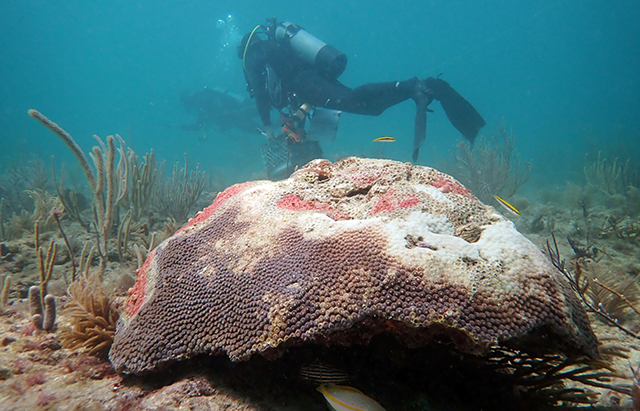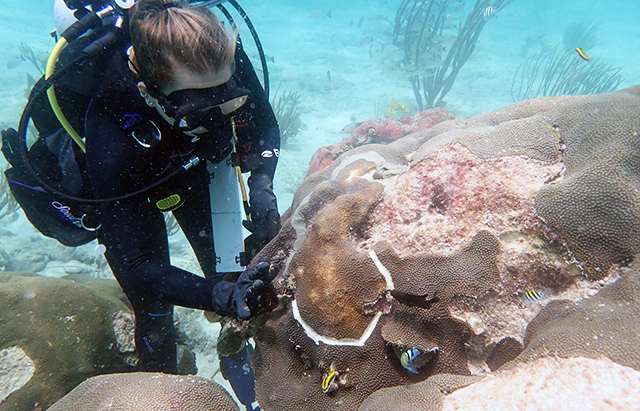Florida’s Coral Reef is a beautiful, national treasure that supports an incredible amount of life and provides jobs, coastal protection, and enjoyment for millions of residents and visitors. Since 2014, Florida’s Coral Reef has been experiencing a widespread and lethal coral disease outbreak called stony coral tissue loss disease (SCTLD). Although disease is a natural part of any ecosystem, SCTLD is worse than any other recorded coral disease due to the combination of its geographic range, longevity, number of species affected, and high mortality rates.

A diseased coral encountered by research divers in Broward County. Credit: Shane O. Wever.
Q: What is the state of the disease in Florida?
A: The most recent scientific surveys in 2022 found that the disease is present at low levels throughout much of Florida’s Coral Reef (a disease state referred to as ‘endemic’). However, sites with large numbers of remaining corals, such as inshore reefs in the Florida Keys and most of the Dry Tortugas, are experiencing outbreak-level conditions in susceptible coral species (a state referred to as ‘epidemic’). The Dry Tortugas region is the area most recently affected by SCTLD in Florida and also currently contains the highest coral cover remaining on Florida’s Coral Reef. Due to the lingering impacts of the disease in endemic areas alongside rapid mortality in epidemic areas, the situation in Florida remains urgent.
Q: How has Florida responded to SCTLD?
A: A highly collaborative and effective team—with partners from federal, state, and local government agencies, non-governmental organizations, universities, aquariums, and members of the diving community—has been researching the disease, developing and applying treatments, rescuing vulnerable and surviving corals, strategically restoring coral populations, and more. Together, these partners have been working to preserve Florida’s Coral Reef and eventually support the recovery of this incredibly important ecosystem, shepherding the reef into a new era of innovation, hope and growing resilience.
Given that the disease didn’t reach the Dry Tortugas National Park until late spring 2021, partners were able to prepare for the arrival of SCTLD and mount a rapid response. Before SCTLD’s arrival, vulnerable stony corals were rescued from the region and placed under expert care at zoos, aquariums, and universities, alongside corals rescued from other parts of Florida’s Coral Reef. These corals were rescued both for safekeeping, and to serve as parent colonies for future coral restoration efforts. In addition, partners from the National Park Service, Nova Southeastern University, University of the Virgin Islands, and FAU Harbor Branch Oceanographic Institute, with funding from the Florida Department of Environmental Protection, collaborated to treat over 12,000 corals impacted by SCTLD.
To date, nearly $30 million has been allocated by the Florida State Legislature, NOAA, EPA, and other sources to support disease response in Florida.
Activities for response and recovery include:
Disease Research & Treatment
— Investigating the cause(s) and spread of SCTLD, including relevant environmental factors.
— Developing new treatments for SCTLD, including antibiotics and beneficial bacteria called ‘probiotics’.
— Using targeted interventions to save corals at high-priority sites throughout Florida’s Coral Reef, from southeast Florida to the Dry Tortugas. As of September 2022, over 22,400 coral colonies have been treated in Florida.Rescue, Holding & Propagation of (Breeding) Corals
— Collecting ~2,500 vulnerable coral colonies of 20 species affected by SCTLD to preserve their genetic diversity in long-term land-based nurseries, and to propagate them for large-scale restoration projects.
— Holding many species in human care for the first time. This has led to discoveries about the life cycles, reproduction, growth, and disease treatment response of these corals, especially for those species held in aquaria for the first time.
— Helping rescued corals reproduce. Offspring from rescued corals have been outplanted back to Florida’s Coral Reef, and over 4,000 baby corals are being produced in land-based facilities every year that will be used for restoration and restoration research projects.
Reef Restoration
— Planning ecosystem-level coral reef restoration to jump-start natural reef recovery, putting Mother Nature back into the driver’s seat.
— Successfully conducting multiple trial outplantings with SCTLD-susceptible coral species, several of which include experiments to determine best practices for coral restoration. Thus far, monitoring shows that disease is uncommon in outplants, suggesting that restoration of impacted species is possible.
— Focusing restoration experiments on building resilient reefs that support natural patterns of recovery based on the latest coral research.
Support For A Healthy Coral Environment
— Recognizing partners must work to improve the overall coral reef environmental condition to ensure the success of response and recovery activities. The disease does not exist in a vacuum.
— Improving water quality across the entirety of Florida’s Coral Reef. There are many ongoing projects to improve water quality. For example, the Florida Keys transitioned from septic to sewer to reduce nutrient pollution, and agencies and municipalities across Biscayne Bay are collaborating on projects to improve water quality across multiple standards.
— Understanding patterns and drivers of resilience to different environmental factors to support the restoration of a sustainable, vibrant coral reef ecosystem.

Scientists apply an antibiotic paste to stop the progression of SCTLD. Credit: Brian Walker.
Q: Is there hope for the future of Florida’s Coral Reef?
A: Since 2014, scores of project partners and researchers have worked diligently and collaboratively to respond to the SCTLD outbreak on Florida’s Coral Reef. Despite the significant impacts of the disease, thanks in large part to the more than eight years of hard work by partners of the response effort, many of these susceptible coral species continue to survive and reproduce in South Florida.
We are, however, seeing juveniles of susceptible species within our surveys. These juveniles are evidence that some susceptible species have the ability to naturally repopulate, offering some hope for the reef tract.
Jennifer Stein
Fish and Wildlife Research Institute
“Now that the disease has made its way across the entire reef tract, we are seeing fewer observations of the disease in southeast Florida and the Florida Keys, potentially due to the dramatic loss of susceptible species,” says Jennifer Stein, a coral biologist with the Fish and Wildlife Research Institute (FWRI). “We are, however, seeing juveniles of these susceptible species within our surveys. These juveniles are evidence that some susceptible species have the ability to naturally repopulate, offering some hope for the reef tract.”
While SCTLD may be the most lethal coral disease ever recorded, there is plenty that provides hope for the future of these essential coral reef animals. Hundreds of experts are working together within the response effort, and cutting-edge research continues to enable response efforts to better understand and protect Florida’s Coral Reef. Recognizing that SCTLD exists in an ocean that faces many other challenges, project partners are working to improve the overall coral reef environmental conditions to ensure the success of response and recovery activities. Redoubling a commitment to supporting healthy coral reefs and recognizing the essential role they play for healthy ecosystems, healthy economies, and healthy humans gives response efforts optimism for the future.
For more information:
- Learn about the teams in the disease response at the DEP Stony Coral Tissue Loss Disease page, and find reports on completed projects as they are added.
- Learn about the partners in the response at the NOAA Florida Keys National Marine Sanctuary Coral Reef Disease Outbreak page.
- Track progress in rescuing and treating corals on the Coral Rescue and Disease Intervention dashboards from FWC
- Visit the Florida Keys National Marine Sanctuary Florida Coral Disease Outbreak: Media Resources for photos, videos, and news about the outbreak and response.
- Find information on impacts and response efforts within National Parks on the National Park Service’s SCTLD page.
- Report diseased corals to FDEP SEAFAN.net – The Southeast Florida Action Network.
- Learn what Caribbean partners are doing at the Atlantic and Gulf Rapid Reef Assessment (AGGRA).
- Hayes, N. K., Walton, C. J., & Gilliam, D. Tissue loss disease outbreak significantly alters the Southeast Florida stony coral assemblage. Frontiers in Marine Science, 1633.
About Florida Coral Disease Outbreak Response Communications and Outreach Team
Since 2014, more than 60 partners from federal, state and local agencies, non-governmental organizations, universities and members of the community have been collaborating on a multifaceted response effort to stony coral tissue loss disease, spanning many teams. The Florida Coral Disease Outbreak Response Communications and Outreach Team is responsible for producing communications products and pieces, working with other teams to review products, and developing and coordinating unified messaging among partners. The Florida Coral Disease Outbreak Response Communications and Outreach Team aims to enhance community understanding, participation, and local stewardship in a coordinated response to the ongoing coral disease outbreak through education and training to improve capacity to participate in monitoring and management programs. For more information, visit floridadep.gov/rcp/coral/content/stony-coral-tissue-loss-disease-response.
Media Contacts
Shelly Krueger, Florida Sea Grant agent, UF/IFAS Extension Monroe County, [email protected]
Dr. Rachel Skubel, Coral Reef Conservation Program Manager, Florida Department of Environmental Protection, Office of Resilience and Coastal Protection, [email protected]
Jennie Lyons, National Oceanic and Atmospheric Administration, [email protected]